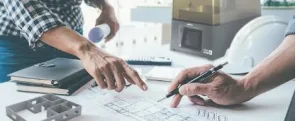What Resin 3D Printing Offers for Designers and Engineers

Resin 3D printing continues to gain attention for its ability to produce highly detailed, smooth, and accurate parts. While it is not new to the world of manufacturing, improvements in printers and materials have made it more practical for businesses that need strong presentation pieces or small runs of functional prototypes.
This type of printing uses liquid resin that hardens when exposed to light. Instead of melting and depositing plastic like other methods, resin printers rely on precision light sources to cure thin layers one at a time. The result is a clean surface finish and the ability to capture details that would be difficult to reproduce with filament-based systems.
This makes resin printing well suited for product design, prototyping, dental and medical models, jewelry design, and collectible figures. But like any manufacturing process, it has both strengths and limitations. Understanding what it can and cannot do helps businesses make better decisions when choosing how to approach a project. You can learn more about various 3D printing technologies and materials at https://www.upsideparts.com/3d-printing
What Resin Printing Does Well
The most recognized strength of resin printing is its ability to capture fine detail. For example, a small logo on a prototype or precise features on a miniature part can appear clearly without the layered texture seen in other processes. This is why designers often choose resin for models that must look polished and professional.
Another benefit is surface quality. Parts printed with resin often come out smooth enough for immediate use or basic post-processing. This reduces the need for sanding or coating, especially when the printed item is intended for visual presentation or customer approval.
The accuracy of resin printing is also useful when parts must fit together precisely. Engineers working on tight tolerances or testing form and fit can benefit from the consistency this process offers.
Finally, there is flexibility in the types of resins available. Some resins are optimized for toughness, others for flexibility, and some for medical or dental use. This range makes it easier to match the material to the demands of a specific application.
Where Resin Printing Has Limits
While resin printing has clear advantages, it is not always the right choice. One of the main limitations is size. Most resin printers have smaller build volumes than filament-based printers. This makes them better suited for small or medium-sized parts rather than large models or enclosures.
Another factor is the post-processing step. After printing, parts must be cleaned with a solvent and cured under UV light. This adds time to the workflow and requires a safe and controlled setup. While it is manageable, it is something to consider for teams working under tight schedules or in shared spaces.
Material handling is also important. Liquid resin needs to be stored and handled carefully. It is sensitive to light and can irritate the skin if touched directly before curing. Proper ventilation and gloves are recommended during use. To explore the details of resin 3D printing process and available options, visit https://www.upsideparts.com/3d-printing/standard-resin
When It Makes Sense to Choose Resin
Resin printing is not a catch-all solution, but it serves a specific role very well. When a part must look clean, precise, and professional, resin printing delivers strong results. It is especially valuable early in product development when visual appeal and accuracy are essential.
Many teams use it to validate designs before investing in more expensive tools or production methods. Others rely on it for making functional models or presentation pieces that need to reflect the final look of a product.
Resin printing is also useful when working with short deadlines. A single part can be printed and finished quickly without tooling or long setup times.
A Useful Tool for Many Industries
From healthcare and consumer products to mechanical design and education, resin printing supports a wide range of applications. It is not the only method worth using, but it provides a practical mix of quality, speed, and material flexibility for professionals who need reliable results in short runs.
As part of a broader 3D printing strategy, it helps teams move from concept to tangible results with fewer delays and less compromise on detail.
